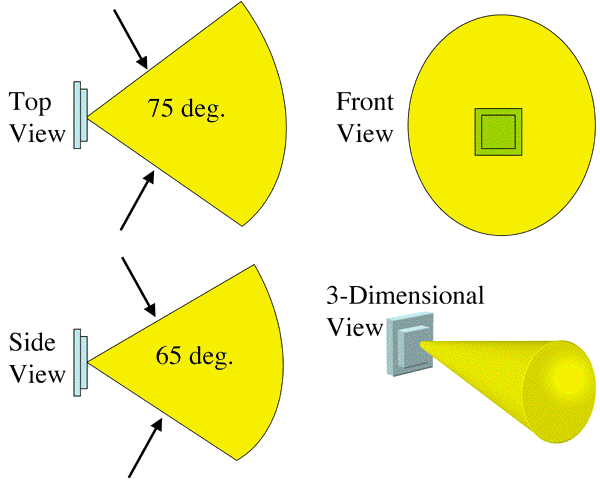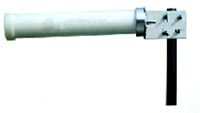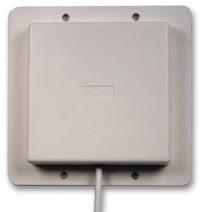How to use Directional Antennas:
Directional antennas usually make the most sense in point-to-point use. They basically focus the signal into a narrow beam instead of letting it radiate in all directions like the isotropic antenna found in your base station. What you will find is that the higher the gain of the antenna, the narrower the focus of that beam. Thus, as the gain increases, so does the need to properly aim the antenna or you'll "miss" the other transmitter you're looking for.
Directional antennas are typically sold by their gain rating. The effect of the gain can be observed in the "beam width" descriptions of each antenna. For instance, a sample 8dbi flat-patch antenna has a vertical beam width of 65 degrees and a horizontal beam width of 75 degrees. Theoretically, think of the resultant shape to look like a cone that emanates from the antenna as sketched below.

The yellow cone represents the coverage of the antenna. Naturally, this is a over-simplification, but it illustrates the principle. Logically, a very high gain antenna has much narrower beam width. For example, typical 24 dbi models have a beam width of just 8 degrees. Thus, while a 8dbi model gives you pretty wide latitude in aiming and making a successful connection, the 24 dbi model is quite a bit more sensitive to proper alignment!
Thus, very-high gain directional antennas are great for applications where you can carefully aim for a distant antenna. Once properly aligned, the high gain ensures the highest transmission rates possible and degree of security as it becomes more difficult to intercept the signal. Very long distances have been covered in experimentation. For example, one enthusiast in New Zealand managed to connect at high speed over a distance of 14 km, or about 9 miles!
If you want to cover long distances, I suggest you ensure clear line of sight (i.e. you can see the other antenna) and reading up on some of the transmission issues like the minimum height required between the transmitters and the surrounding ground to maintain signal integrity. The online calculator developed by Green Bay Packet Radio is incredibly comprehensive... it even allows you to compensate for rain!
Directional antennas with low gain settings can be useful in a number of environments. For example, you may like the directional aspect to limit the propagation of your wireless network in certain directions. For instance, you could mount antennas on the inside perimeter of your building to face away from a street it adjoins. Thus, while you would have excellent coverage inside the building, it would make it harder for people outside to eavesdrop on or use your network.
In essence, directional networks give you a degree of control who can and cannot receive the signal coming out of the transmitter. However, signals may get reflected and bounced around along the journey, so the real world isn't as airtight as one might hope. Directional antennas come in many different shapes and sizes.
| Tube-Style Yagi | Tooth-Style Yagi | |
|---|---|---|
 Yagi antennas come in several different styles. This one looks like a tube. The longer the tube, the higher the gain. Inside, there are a number of rings whose spacing and diameter correspond with the frequency that the antenna is supposed to work at. Fab-Corp sells a 14.6dbi Antennex Tube-Style Yagi for $75. |
 Here is another Yagi antenna that uses "teeth" to pick up and transmit the 2.4GHz signal. Note the inexpensive built-in aiming mechanism for pole-mounting. Fab-Corp sells a similar 16dbi "Vagi" Antenna for $38, though it also requires a N-Male Pigtail. | |
| Parabolic-Style Yagi | Patch-Style Yagi | |
 The highest gain antennas available are shaped like satellite dishes and may consist of a grid of wires or a solid shape. The 24 dBi Die Cast Directional Antenna at Fab-Corp costs $60 and requires a Pigtail. Besides offering high gain, grid-style antennas also offer a pretty low wind-load for outdoor installations. With high gains like these, exceptional care has to be taken to aim the antenna and ensure proper polarization. Both antennas have to have the same polarization (horizontal or vertical) to ensure proper signal reception - if they're not aligned right, up to 20db of signal loss will occur. |
 Flat Panel or Patch Antennas can range from low to high gains. They are attractive for many users because they are fairly inexpensive and flat. Therefore, it is easy to mount them on walls and other surfaces rather than resorting to installing a pole and then mounting the antenna on the pole. Fab-Corp sells a 18dbi Patch antenna for $45 by Maxrad that has a N-Male connector. In other words, this antenna too needs a Pigtail adapter. However, it tends to be the easiest to hide indoors or to mount permanently on an adjustable jig. |
The FCC in the USA makes a provision for point-to-point systems, allowing them to have much higher EIRPs than point-to-multipoint systems (4W). Starting with a 30dbm transmitter, a 6dbi antenna is allowed. For every dbm of transmitter power reduction, the antenna gain can be increased by 3dbi. If I interpret this rule correctly, the law allows some fairly ridiculous antenna gain possibilities.
| Transmitter Power | Max. Allowable External Antenna Gain for "Point-Point" Use Set by FCC | Effective EIRP | ||
|---|---|---|---|---|
| (mW) | (dbm) | (dbm) | (W) | |
| 35 | 15 | 51dbi | 66db | 4400 |
| 100 | 20 | 36dbi | 56db | 400 |
| 200 | 23 | 27dbi | 50db | 100 |
| 500 | 27 | 15dbi | 42db | 16 |
| 1000 | 30 | 6dbi | 36db | 4 |
Thus, please be especially careful when combining very high-gain antennas with powerful microwave transmitters. DO NOT point such combinations at anything alive. Besides, the whole benefit of very high-gain antennas and amplifier combinations (super-long range) is lost unless they are placed very high up (to account for the curvature of the earth, among other things, the frensel zone between the antennas, etc.). Use this EIRP calculator to see if your EIRP stays within the legal limits.
Several readers have asked me if the internal antenna of a "Graphite" base station will continue to function after attaching a external one. The answer is no! You can use one or the other, but not both. "Snow" and "Extreme" base station owners can't even wish for this, as their base stations do not feature a PC-Card with a built-in antenna.
Several readers have inquired about splitting the signal between a small antenna for local use and a directional one to pick up a faraway client or network. There are several hazards which make this sort of idea unfeasible. For one, hooking up two networks via different antennas to one transmitter will cause all sorts of weird problems with interference. Furthermore, it is not economical. You're better off getting another base station.
Lastly, there is nothing that prevents you from mixing directional and omni-directional antennas. For example, I recently installed a system at a friends house that consists of a base station with a 8dbi omni-directional antenna. A "client" in the barn connects an office to the main house via a 14dbi "patch" antenna. This antenna ensures a strong connection and since it's running from a fixed location, aiming it is a one-time affair. We didn't even need to mount the antenna on the outside - it works from inside the office! Within the house and most of the grounds, my friends can now run around and enjoy wireless access. I hope to post a story on this subject soon.


